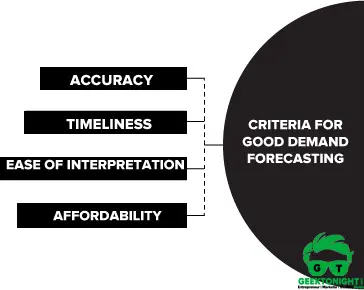Criteria for Good Demand Forecasting
Demand forecasting can be effective if the predicted demand is equal to the actual demand. The effectiveness of demand forecasting depends on the selection of an appropriate forecasting technique.
Each technique serves a specific purpose; thus an organisation should be careful while selecting a forecasting technique for a particular problem.

Table of Content [Show]
The following points explain the criteria for the selection of demand forecasting technique:
Criteria for Good Demand Forecasting

Accuracy
Almost all the methods of demand forecasting yield accurate results under different circumstances. However, not all methods are appropriate to be used for all kinds of forecasting.
For example, a lack of statistical data limits the use of regression analysis in order to predict demand. Therefore, an appropriate selection of forecasting technique would ensure the accuracy of results.
Timeliness
As discussed earlier, demand forecasting can be short term or long term. The demand forecasting methods used for both the time periods vary.
For example, the demand for a new product, which needs to be introduced in a month’s time, cannot be assessed using the time series analysis method. This is because this method requires data collected over long periods.
Affordability
The cost for different demand forecasting methods varies based on its implementation, expertise required, the time period involved, etc. Thus, organisations should select a method that suits their budget and requirements without compromising on the outcome.
For example, the complete enumeration method of demand forecasting yields accurate results but could prove expensive for small-scale organisations.
Ease of interpretation
Outcomes generated using demand forecasting methods are generally represented in the form of statistical or mathematical equations. Therefore, it should be ensured that personnel carrying out forecasting are trained and efficient to use forecasting methods and interpret the results.
Leave a Reply